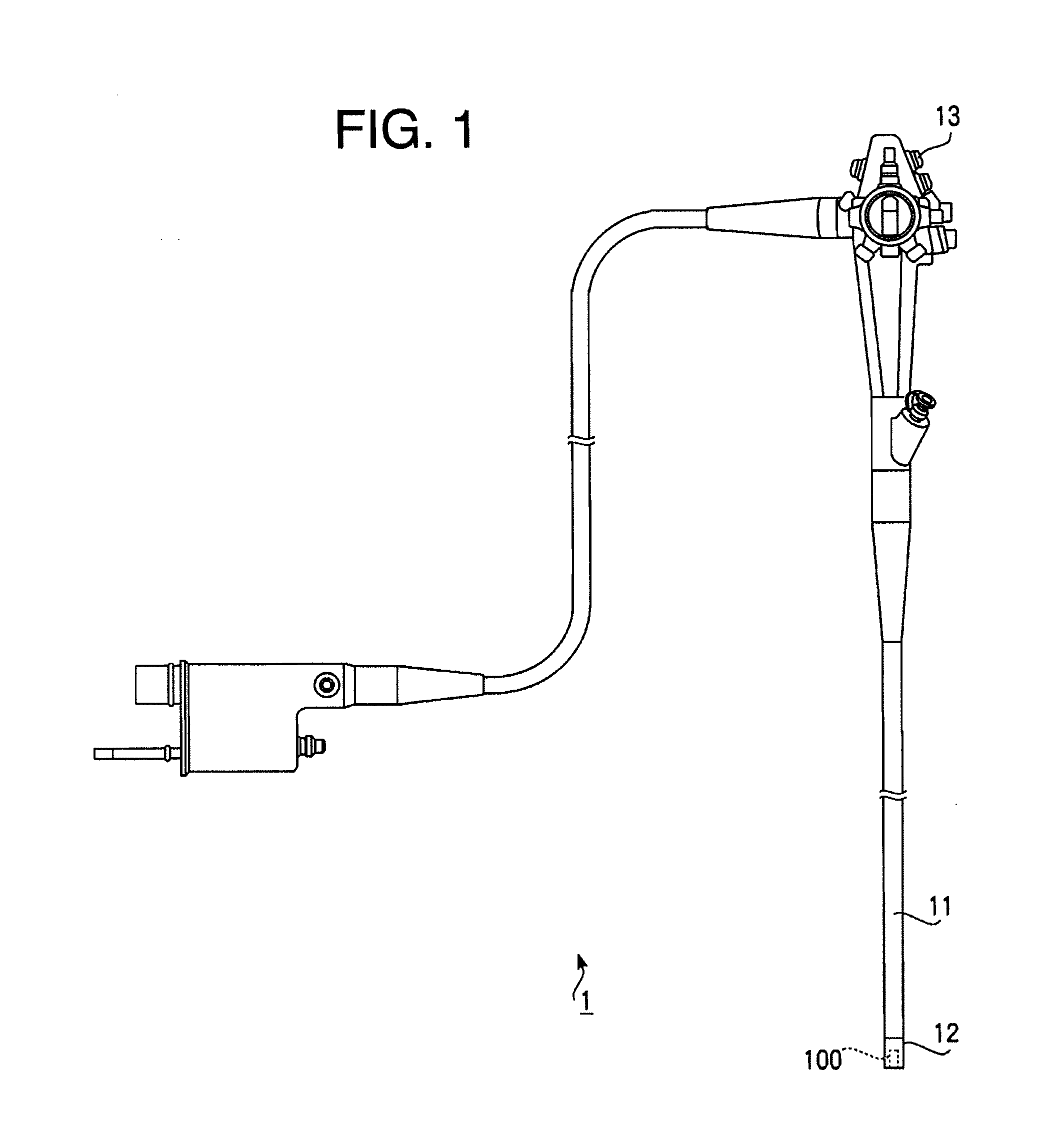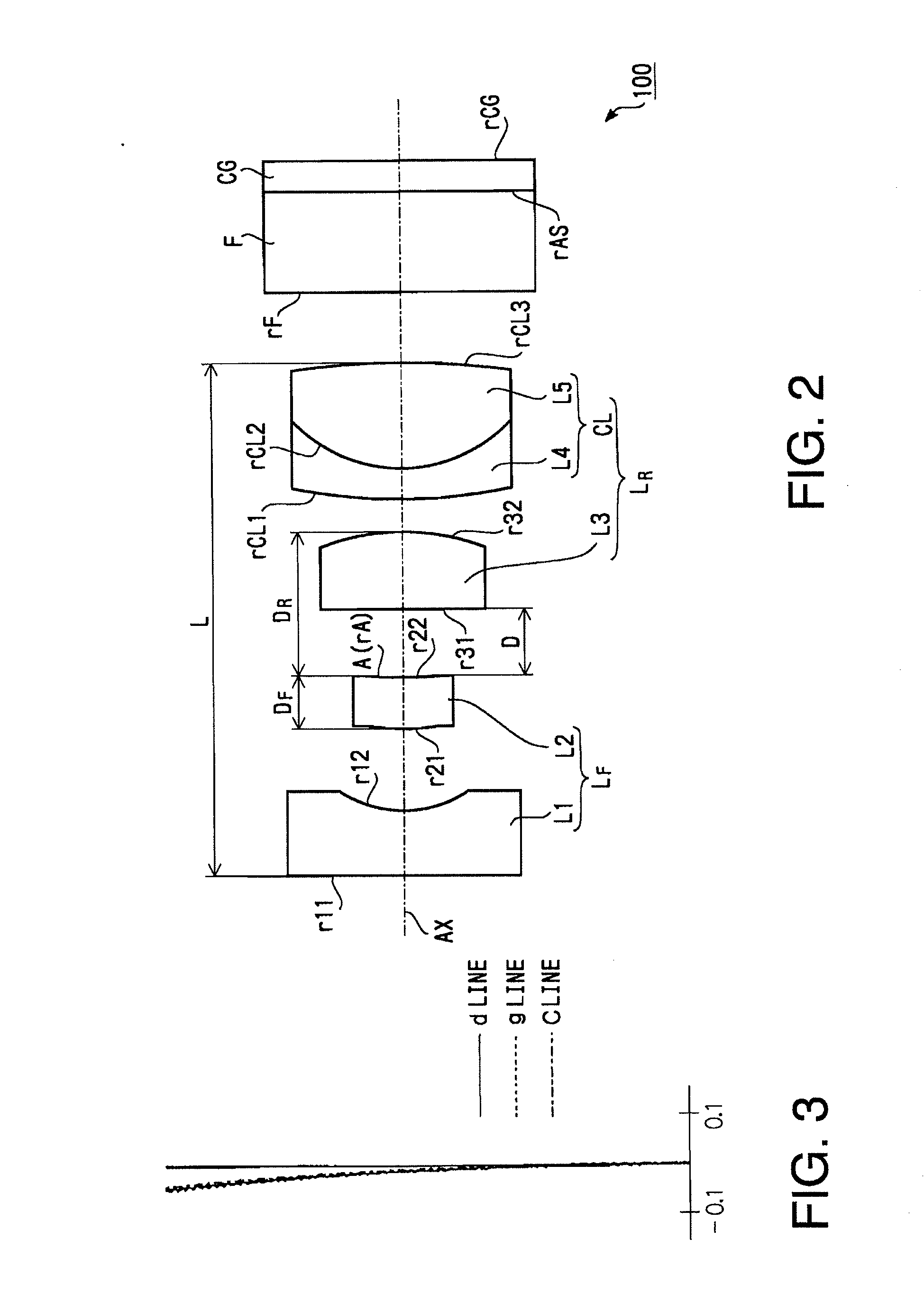Endoscope and objective lens for the same
- Summary
- Abstract
- Description
- Claims
- Application Information
AI Technical Summary
Benefits of technology
Problems solved by technology
Method used
Image
Examples
first example
[0102]As described above, FIG. 2 shows the configuration of the objective lens 100 according to a first example of the invention. Table 1 shows a concrete numerical configuration (design values) of the objective lens 100 according to the first example and the optical components arranged on the rear side of the objective lens 100. In Table 1 (and in the following similar tables), r (unit: mm) denotes an curvature radius of a surface of each optical component, d (unit: mm) denotes the thickness of an optical component or the distance (unit: mm) from each optical surface to the next optical surface, “Nd” denotes a refractive index at a d-line (a wavelength of 588 nm), and vd denotes Abbe number at the d-line. “r” of an aspherical element is a curvature radius defined on the optical axis AX. In Table 1, the surfaces #1 and #2 respectively denote the first surface r11 and the second surface r22 of the negative lens L1, surfaces #3 and #4 respectively denote the first surface r21 and the ...
second example
[0107]Hereafter, a second example of the invention is explained. FIG. 7 is a side view illustrating a configuration of the objective lens 100 according to the second example and the optical components arranged on the rear side of the objective lens 100. Table 3 shows the concrete numerical configuration (design values) of the objective lens 100 according to the second example and the optical components arranged on the rear side of the objective lens 100. Table 4 shows the coefficients (design values) defining aspherical surfaces of the first surface r21 of the positive lens L2 and the second surface r32 of the positive lens L3.
[0108]ω: 70.0
[0109]y: 1.05
TABLE 3Surface No.rdNdνd1∞0.5201.8830040.820.8860.613——31.8900.5061.8640040.64∞0.000——5∞0.065——6−2.7371.0721.8640040.67−1.2360.570——87.4340.2481.9228618.991.2680.8921.7725049.610−3.6870.606——11∞0.8251.5163364.212∞0.2481.5100064.113∞———
TABLE 4Surface No.κA4A6A830.000−0.8855E−020.2226E+01−0.1025E+0270.0000.4491E−01−0.1476E+000.2817E+00
[...
third example
[0111]Hereafter, a third example of the invention is explained. FIG. 12 is a side view illustrating a configuration of the objective lens 100 according to the third example and the optical components arranged on the rear side of the objective lens 100. Table 5 shows the concrete numerical configuration (design values) of the objective lens 100 according to the third example and the optical components arranged on the rear side of the objective lens 100. Table 6 shows the coefficients (design values) defining aspherical surfaces of the first surface r21 of the positive lens L2 and the second surface r32 of the positive lens L3.
[0112]ω: 73.3
[0113]y: 1.08
TABLE 5Surface No.rdNdνd1∞0.5191.8830040.820.8690.687——32.4750.4331.8640040.64∞0.000——5∞0.534——6∞0.6341.8640040.67−1.6960.349——85.6070.4121.9228618.991.2190.9371.7725049.610−4.7030.646——11∞0.8241.5163364.212∞0.2471.5100064.113∞———
TABLE 6Surface No.κA4A6A830.0000.1191E+000.1782E+000.0000E+0070.0000.4808E−01-0.4831E−010.3964E−01
[0114]FIGS...
PUM
 Login to View More
Login to View More Abstract
Description
Claims
Application Information
 Login to View More
Login to View More - R&D
- Intellectual Property
- Life Sciences
- Materials
- Tech Scout
- Unparalleled Data Quality
- Higher Quality Content
- 60% Fewer Hallucinations
Browse by: Latest US Patents, China's latest patents, Technical Efficacy Thesaurus, Application Domain, Technology Topic, Popular Technical Reports.
© 2025 PatSnap. All rights reserved.Legal|Privacy policy|Modern Slavery Act Transparency Statement|Sitemap|About US| Contact US: help@patsnap.com



